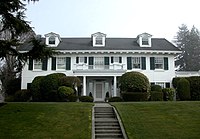
Colonial Revival architecture
The Colonial Revival architectural style seeks to revive elements of American colonial architecture.
The beginnings of the Colonial Revival style are often attributed to the Centennial Exhibition of 1876, which reawakened Americans to the architectural traditions of their colonial past.[1] Fairly small numbers of Colonial Revival homes were built c. 1880–1910, a period when Queen Anne-style architecture was dominant in the United States.[1] From 1910–1930, the Colonial Revival movement was ascendant, with about 40% of U.S. homes built in the Colonial Revival style.[1] In the immediate post-war period (c. 1950s–early 1960s), Colonial Revival homes continued to be constructed, but in simplified form. In the present-day, many New Traditional homes draw from Colonial Revival styles.[1]
Although associated with the architectural movement, "Colonial Revival" also refers to historic preservation, landscape architecture and garden design, and decorative arts movements that emulate or draw inspiration from colonial forms.[2]
While the dominant influences in Colonial Revival style are Georgian and Federal architecture, Colonial Revival homes also draw, to a lesser extent, from the Dutch Colonial style and post-medieval English styles. Colonial Revival homes are often eclectic in style, combining aspects from several of these previous styles.[1][3]
Since Colonial Revival architecture pulls structural and decorative elements from other styles, there is not one single combination of elements that defines the style. However, some commonly found characteristics of Colonial Revival buildings include:[4][3]
Cyril M. Harris's American Architecture: An Illustrated Book noted that "Colonial Revival houses are usually the result of a rather free interpretation of their prototypes; they tend to be larger, may differ significantly from the houses they seek to emulate, and often exaggerate architectural details."[5]









